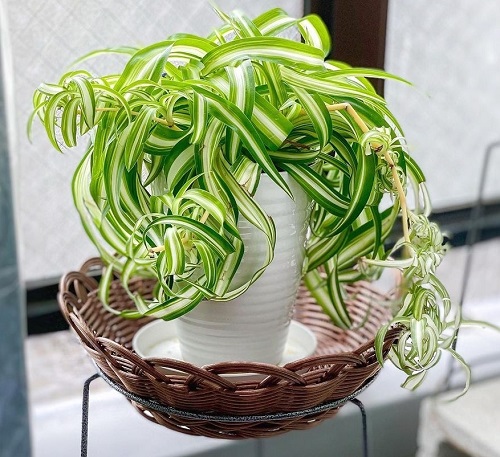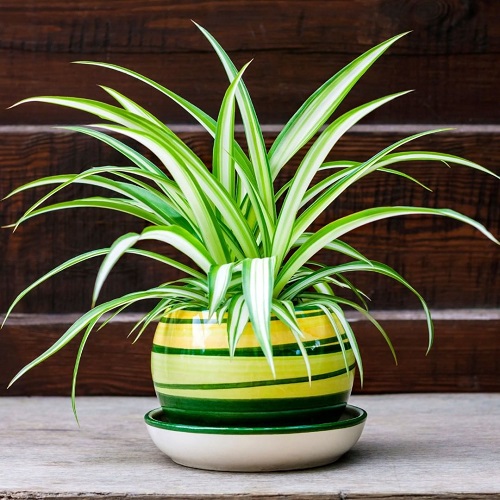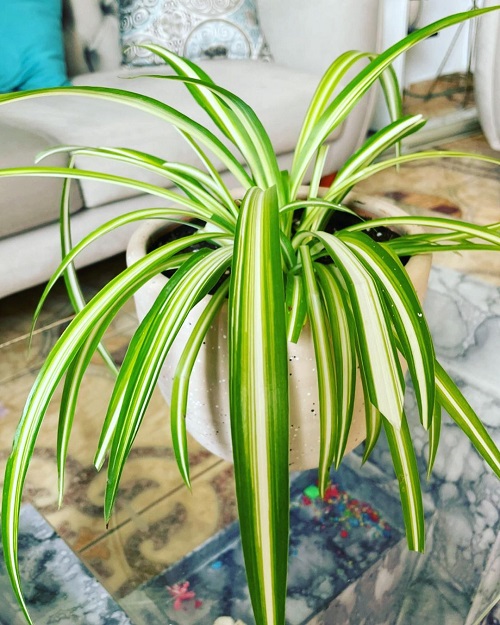Bring home a touch of tropics with the unique Hawaiian Spider Plant! Help it thrive with this Chlorophytum comosum Care Guide!

Native to the South African tropics, Hawaiian Spider Plant adds an exotic touch to the bland corners with its eye-catching curly foliage besides. Studies have proven spider plants to be excellent houseplants for detoxifying indoor air quality. Additionally, the plant’s low care requirements of this specimen make it perfect for urban apartments and offices. Experience the joy of watching a Hawaiian Spider Plant thrive in your home with this extensive care guide!
- Botanical Name: Chlorophytum comosum
- Popular as—Ribbon Plant, Airplane Plant
- Grows upto 14-18 inches high
- Prefers temperature range of 70-90F or 21-32C
- Thrives well in bright and indirect light
- Non-toxic to pets
Hawaiian Spider Plant Profile
Popular as Ribbon plant or Airplant plant, the Hawaiian spider plant is a member of the lily family and is characterized by its upward growing long, slender leaves with pointed tips bending downwards. The foliage is typically green with white or yellow stripes running down the center that often coil up while cascading down the pots. Apart from its aesthetic appearance, the plant also stands apart with its prominent air-purifying qualities.
Growing to a cute height of 14-18 inches, the Hawaiian Spider Plant can be a wonderful addition, sitting in hanging baskets, bookshelves, center tables, or amidst your houseplant collection.
Ideal Pot Size
It’s essential to select a pot for your Hawaiian Spider Plant that is one size bigger than the plant’s root ball. Go for a 4-6 inches pot with 2-3 holes at the bottom to allow proper aeration and drainage.
Terracotta pots are a good option due to their porosity and ability to provide sufficient ventilation to the roots. While plastic or ceramic pots will complement the beautiful foliage really well.
Propagating Hawaiian Spider Plant Indoors

Hawaiian Spider Plants are quite simple to propagate. The easiest method is to root the baby plantlets around the mother plant.
- Get a healthy, disease-free Hawaiian Spider Plant and unpot it to detach the plantlets.
- Take a healthy plantlet and remove the dull, yellow leaves from the stolon.
- Fill a jar with clean, nonchlorinated water and put the plantlet into it.
- Ensure that only the bottom 2-3 inches is submerged in water.
- Change the water every alternate day or when it turns muddy.
- Keep the plant at a location with bright, indirect sunlight.
You’ll notice the stolen sending out roots in about 2-3 weeks. Transplant the rooted baby plant to a well-draining medium once you find them growing 2-3 inches long.
Requirements of Hawaiian Spider Plant

Light
Chlorophytum comosum flourishes well in bright and indirect sunlight. Although they can handle some sunlight, excess will scorch the foliage. On the other hand, they grow lankier with stunted leaf growth in low-light conditions.
The best location for your Hawaiian Spider Plant indoors is close to a North oe East facing window that receives enough natural light yet shields it from the direct afternoon sun.
Soil
The Hawaiian spider plant thrives in organically rich, well-draining soil. The ideal growing mix should have good air circulation and moisture retention with equal parts of peat moss or sphagnum moss, perlite, and sand enriched with a handful of organic fertilizer.
Pro tip: The Hawaiian spider plant also needs a variety of micronutrients, such as calcium, magnesium, iron, and manganese, in addition to these three essential nutrients. By employing a balanced fertilizer or adding compost to the soil mixture, these micronutrients can be provided.
Water
Ribbon plants grow best in a moist medium that does not pool water. Water the medium when the top inch feels dry to the touch. A deep watering session once or twice a week is a helpful practice that’ll maintain proper moisture balance in the medium. It’s essential to prevent overwatering the plant because this can result in root rot and fungal problems.
Use distilled or filtered water instead of chlorinated water because the latter might be bad for plants. You can also let the tap water sit for 24 hours before using tap water to allow the contaminants to settle down.
Temperature & Humidity
Hawaiian Spider Plants prefer temperatures of 70-90 °F (15 to 24 °C). Although they can withstand low temperatures of 50 °F (10 °C), they are vulnerable to cold drafts and abrupt temperature changes. As a result, it’s critical to keep them away from heaters or air conditioners.
High humidity is preferred by Hawaiian Spider Plants; ideally, it ranges from 40% to 60%. By spraying your plant frequently with tepid water, keeping a tray of water nearby, or using a humidifier, you can raise the humidity level of your indoors.
Hawaiian Spider Plant Care

Fertilizers
The Hawaiian spider plant needs the following essential fertilizers in its soil, which can encourage robust growth in plants:
- Nitrogen: Helps plants synthesize chlorophyll, which is necessary for photosynthesis.
- Phosphorus: Phosphorus is necessary for the growth of roots and is also involved in the transfer of energy within plants.
- Potassium: Potassium is important for the overall health of plants and aids in controlling the water balance within them.
- Organic fertilizers: Fertilizers like compost, fish emulsion, or worm castings are gentle on plants and can gradually enhance soil quality.
Feed the plant with a balanced NPK blend every 4-6 weeks after diluting it to half its strength during the growing season. Additionally, you can also shower it with a liquid fertilizer every month at the beginning of spring through summer. Do not fertilize during the colder months when the plant is in its dormancy.
Pest and Diseases
Spider plants are quite robust and resistant to pest infestations; however, they can occasionally be vulnerable to some common houseplant pests like aphids, mealybugs, or spider mites. In order to smother the bugs, you can try treating the plant by misting it with a solution of water and dish soap, commercial insecticidal soap, neem oil, or horticultural oil.
Make sure your plant is receiving the proper amount of light, water, and fertilizer to avoid further pest invasions. Moreover, you can routinely wipe the leaves of your plants with a wet cloth to check for pest symptoms.






